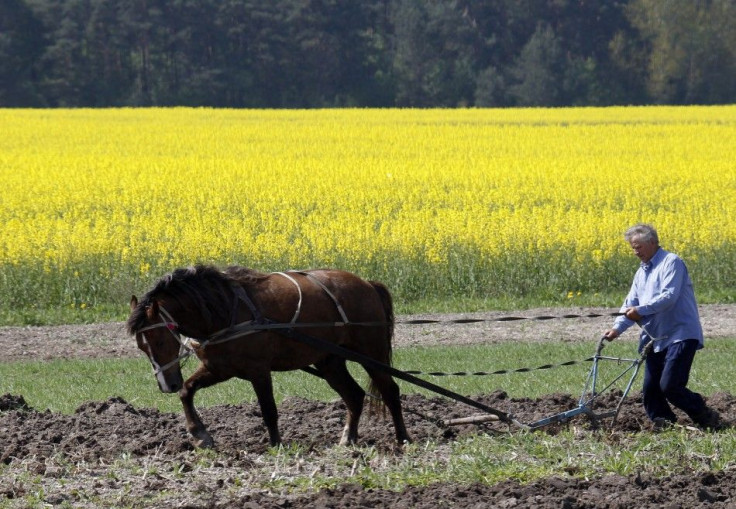Ukraine Land Reform: the Next Big Agricultural Boom?
ANALYSIS

Theoretically speaking, a sensible Ukraine land reform could set off an agricultural boom in a country commonly known as the “breadbasket of Europe.”
Ukraine used to account for one fourth of the Soviet Union agricultural output. It is the third largest European country after Russia and Kazakhstan and 54 percent of its land is arable, according to the CIA.
The quality of the land is also superb; it possess 30 percent of the world’s black soil, according to Bloomberg News. Moreover, Ukraine’s labor cost remains relatively cheap.
The country’s actual agricultural output, however, is by all measures subpar by global standards.
It only ranks 2nd in barley, 8th in sugar beets, 11th in wheat, and 17th in cow milk, according to the FAO. The only thing it ranks first for is sunflower products.
The state of Ukraine’s agriculture industry can be summed up in one word: potential.
Ukraine’s own Foreign Minister Konstantin Grishchenko thinks it is possible to increase agricultural production by fourfold in the next five years. This estimate is in line with other expert opinions.
A limited segment of Ukraine’s farming is high-tech.
However, there are far too many pockets of farmland worked by “women hold cows on pieces of string by the side of the road and dozens of workers perform back-breaking labor in strip-field,” wrote Leigh Turner, the UK ambassador to the Ukraine.
So what is preventing Ukraine agriculture from modernizing?
Given Ukraine’s fertile farmland and rising food prices globally, investors should want to deploy the latest farming technology to Ukraine’s agricultural sector and reap enormous profits.
Unfortunately, Ukraine’s farmland situation is a mess.
The country’s farmland is owned by a multitude of former farm workers (and their descendants) of the Soviet-era state and collective farms.
The first problem is that Ukraine does not have a transparent and easily accessible national system that clearly shows land location and ownership.
The second problem is that because landownership is so fragmented, it is sometimes difficult to bring many landowners together and make a decision. A moratorium on farmland sales keeps this market in its fragmented state.
These two problems make it difficult for investors to gain control of farmlands and deploy modern agricultural tools to them.
Currently, some large commercial operators have had some success leasing large tracts of farmland from multiple individual owners.
However, this is far from the norm. Moreover, these commercial operators face the uncertainties that come with medium-term leases, which spook them from long-term planning and investments.
Ukraine will soon commence the first hearing of a legislation that would lift the moratorium on farmland sales.
At first glance, it seems the passage of this land reform bill could pave the way for capitalists to modernize a big bulk of the Ukrainian agricultural sector.
However, Martin Raiser, World Bank Country director for Ukraine, disagrees. In short, Raiser thinks Ukraine is simply not ready.
First, he thinks Ukraine needs a national computerized information system that clearly shows land location and ownership.
Second, he thinks the Ukrainian financial system still hinders the flow of capital to farming operations, both foreign and domestic.
Farmland in Ukraine cannot practically be used as collateral for loans. The loans that are made to the farming sector usually carry extremely high interest rates, partially because the state does not guarantee them. Banks also typically require 200 to 300 percent in collateral in the form of crops and farm machinery, according to the USDA.
Lastly, there is the matter of excessive red tape and rampant corruption on a national scale.
The latest Transparency International corruption index ranked Ukraine 134 out of 178 countries. A 2011 report from the Financial Times stated that investors are finding “shakedowns by officials and non-transparent dealings” to be escalating to “unprecedented levels.”
The heart of Ukraine’s agricultural problem is the disconnect between potential and capital.
Ukraine’s fertile lands obviously have the potential to yield crops and generate a positive return for investors. However, distortions – many of them inherited from history – prevent capital from deployed there.
Historically, the rise and fall of industries globally have often hinged on capital.
The U.S. real estate bubble, for example, was fueled by excessive capital in the 2000s due to low interest rates and loose lending standards. After it burst in 2008, it has been constrained by the dearth of capital due to tight lending standards.
Modern farming is a capital intensive exercise and capital conditions for the Ukrainian agricultural sector are undoubtedly on the tight side.
If the Ukrainian agricultural sector were to modernize, policymakers need to open the floodgates on capital. Land and banking reforms will help. Ukraine also needs to strengthen the rule of law and cut down on corruption and red tape.
In short, the country has a long ways to go.
For the vigilant investor, however, it offers an opportunity for profit.
History has also shown that countries can change. India broke free from its so-called low “Hindu rate of growth” in the 1990s and China embarked on a multi-decade economic miracle starting in 1978.
China and India, due to their size and demographics, had explosive potentials that were eventually unleashed by the right policies.
Ukraine, too, has this kind of potential in its agricultural sector, especially on the back of a rising middle class in large emerging market countries like China and India. It just needs the right policies to unleash it.
Follow Hao Li on Twitter @hao_li_ibt
© Copyright IBTimes 2024. All rights reserved.





















